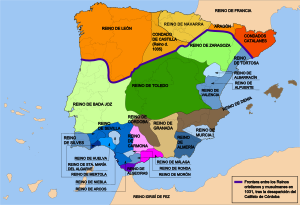Parias facts for kids
In medieval Spain, parias were special payments made by the Muslim kingdoms (called taifas) in the south to the Christian kingdoms in the north. Think of them as a type of tribute or "protection money." The word parias comes from a medieval Latin word meaning "to make an account equal," or simply "to pay."
These payments were a big part of how Muslim and Christian states interacted in Spain. This was especially true after the Caliphate of Córdoba broke apart in 1031. The parias system continued until the Almoravid dynasty reunited Islamic Spain starting in 1086.
When a taifa paid parias, the Christian kingdom promised to protect it. This protection was against other Muslim groups or even other Christian groups. Often, these payments were forced. A Christian army might threaten a large attack (a razzia) or demand money to support one Muslim group against another. The word "taifa" itself means "party kingdom," showing how divided Islamic Spain was at that time.
History of Parias Payments
The first records of parias come from eastern Spain. The Kingdom of Aragon and the County of Barcelona collected early payments. One very old payment, called the vetus paria (old paria), came from the Taifa of Zaragoza.
One of the earliest parias that can be dated was collected in 1045. Raymond Berengar I of Barcelona got it from Lleida and Zaragoza after attacking their lands. In the 1060s, he was still demanding parias from Lleida, Zaragoza, and the taifa of Tortosa. The Aragonese king Sancho Ramírez also took parias from Muslim leaders in Huesca and Tudela. These leaders were under the king of Zaragoza.
In western Spain, Ferdinand I of León and Castile was the first ruler to demand such tribute. From at least 1060, and possibly as early as 1055, Ferdinand collected parias. He received them from the taifas of Seville, Toledo, and Zaragoza. He might have also received them from Badajoz and Valencia.
When Ferdinand died in December 1065, his parias were divided among his sons. His eldest son, Sancho II, received Castile and the vetus paria. His second son, Alfonso VI, received León and the parias from Toledo. The third son, García II, received Galicia and the parias from Badajoz and Seville.
Eventually, all these tribute payments ended up with Alfonso VI. He also collected parias from Granada. Later, the city of Valencia was taken by Rodrigo Díaz de Vivar (also known as El Cid) in 1094. When Muslims took Valencia back, it briefly paid parias to Barcelona. These payments were later started again by Raymond Berengar IV.
These parias were still being collected during the reign of James I the Conqueror (1213–1276). He finally ended them by conquering Valencia.
Much of the wealth from parias was given to cathedrals and monasteries. Some also went to the aristocracy (rich noble families). For example, between 1053 and 1065, Ferdinand of León promised 1,000 gold coins (aurei) each year to the Abbey of Cluny in France. Alfonso VI renewed this gift in 1077 and increased it to 2,000 aurei in 1090. This was the largest gift Cluny ever received from a king. These large payments helped pay for the huge third abbey church at Cluny. This also helped spread the word about Spain's wealth across Europe.
However, the payments to Cluny stopped in 1111 due to changes in Spain. This caused money problems for the abbey. By 1100, the parias had greatly decreased. It wasn't until 1246 that parias became a major source of wealth again for Christian Spain. This happened when the Kingdom of Granada, the last Muslim state in Spain, agreed to pay half of its yearly income in parias to Castile. Even though the amount was sometimes lowered, the kings of Granada had to tax their people much more than was allowed by Islamic law.
How Much Were Parias Payments?
Parias were usually paid in gold coins. These were often Islamic dinars or mithqals. Along with gold, gifts like carpets, silks, ivory items, and other fancy goods were given. These luxury items were not widely made in Christian Europe at the time.
The amounts were very large for that period. However, it's hard to know their exact value in today's money. Around 1060, the vetus paria paid to Ferdinand of León was about 10,000 gold coins per year. This amount went up to 12,000 gold coins per year when Sancho IV of Navarre took it over.
In 1075, Alfonso VI arranged to get 30,000 mithqals from Granada. This included two years of unpaid amounts. This meant the yearly parias was about 10,000 mithqals, similar to the vetus paria. The largest parias ever recorded were forced on the eastern taifas by Alfonso's ally, Rodrigo Díaz de Vivar (El Cid), between 1089 and 1091. During this time, he collected 146,000 dinars.
To give you an idea of these amounts:
- A typical nobleman's ransom in Spain at that time cost 500–1,000 gold coins.
- In Córdoba in the 1060s, 400 horses or 70 human slaves were worth about 10,000 mithqals.
Historian Richard Fletcher noted that Christian kings in Spain quickly became very rich. Before parias, they were among the poorest rulers in Europe. The kingdom of León-Castile, especially, became known for its huge wealth in the second half of the 11th century. This was largely because of the parias they received.
See also
 In Spanish: Parias (tributo) para niños
In Spanish: Parias (tributo) para niños



